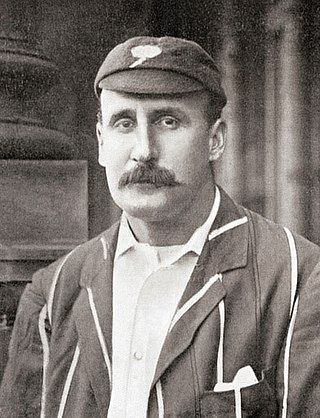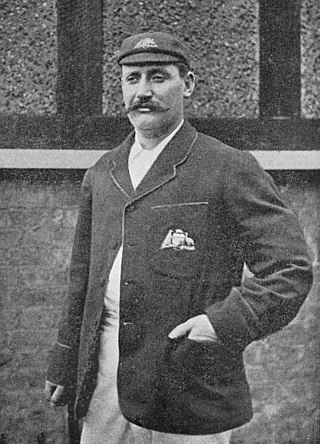Related Research Articles

Sir Leonard Hutton was an English cricketer. He played as an opening batsman for Yorkshire County Cricket Club from 1934 to 1955 and for England in 79 Test matches between 1937 and 1955. Wisden Cricketers' Almanack described him as "one of the greatest batsmen in the history of cricket". He set a record in 1938 for the highest individual innings in a Test match in only his sixth Test appearance, scoring 364 runs against Australia, a milestone that stood for nearly 20 years. Following the Second World War, he was the mainstay of England's batting. In 1952, he became the first professional cricketer of the 20th century to captain England in Tests; under his captaincy England won the Ashes the following year for the first time in 19 years.

Martin Bladen Hawke, 7th Baron Hawke, generally known as Lord Hawke, was an English amateur cricketer active from 1881 to 1911 who played for Yorkshire and England. He was born in Willingham by Stow, near Gainsborough, Lincolnshire, and died in Edinburgh. He appeared in 633 first-class matches, including five Test matches, as a righthanded batsman, scoring 16,749 runs with a highest score of 166 and held 209 catches. He scored 13 centuries and 69 half-centuries.

Norman Walter Dransfield Yardley was an English cricketer who played for Cambridge University, Yorkshire County Cricket Club and England, as a right-handed batsman and occasional bowler. An amateur, he captained Yorkshire from 1948 to 1955 and England on fourteen occasions between 1947 and 1950, winning four Tests, losing seven and drawing three. Yardley was named Wisden Cricketer of the Year in 1948, and in his obituary in Wisden Cricketers' Almanack he was described as Yorkshire's finest amateur since Stanley Jackson.

Robert Peel was an English professional cricketer who played first-class cricket for Yorkshire between 1883 and 1897. Primarily a left-arm spin bowler, Peel was also an effective left-handed batsman who played in the middle order. Between 1884 and 1896, he was regularly selected to represent England, playing 20 Test matches in which he took 101 wickets. Over the course of his career, he scored 12,191 runs and took 1,775 wickets in first-class cricket. A match-winning bowler, particularly when conditions favoured his style, Peel generally opened the attack, an orthodox tactic for a spinner at the time, and was highly regarded by critics.

George Henry Stevens Trott was an Australian cricketer who played 24 Test matches as an all-rounder between 1888 and 1898. Although Trott was a versatile batsman, spin bowler and outstanding fielder, "it is as a captain that he is best remembered, an understanding judge of human nature". After a period of some instability and ill discipline in Australian cricket, he was the first in a succession of assertive Australian captains that included Joe Darling, Monty Noble and Clem Hill, who restored the prestige of the Test team. Respected by teammates and opponents alike for his cricketing judgement, Trott was quick to pick up a weakness in opponents. A right-handed batsman, he was known for his sound defence and vigorous hitting. His slow leg-spin bowling was often able to deceive batsmen through subtle variations of pace and flight, but allowed opposition batsmen to score quickly.

Thomas Walter Hayward was an English first-class cricketer who played for Surrey and England between the 1890s and the outbreak of World War I. He was primarily an opening batsman, noted especially for the quality of his off-drive. Neville Cardus wrote that he "was amongst the most precisely technical and most prolific batsmen of any time in the annals of cricket." He was only the second batsman to reach the landmark of 100 first-class centuries, following WG Grace. In the 1906 English season he scored 3,518 runs, a record aggregate since surpassed only by Denis Compton and Bill Edrich in 1947.
1890 was the 104th season of cricket in England since the foundation of Marylebone Cricket Club (MCC) and the first in which the County Championship was held as an official competition, following agreement between MCC and the leading county clubs at a meeting in December 1889. Surrey became the first official county champions after winning nine out of fourteen games.
1894 was the fifth season of County Championship cricket in England. The championship culminated in a close battle between Surrey and the 1893 champions Yorkshire. Before the round of 23 August, the two teams were tied on 10 points, with one match left to play and all other teams out of contention. Yorkshire travelled to Taunton to play Somerset and, after the first day was rained off, Somerset had to bat on a rain-affected pitch. George Hirst took seven for 32 as Somerset were dismissed for 99, but Yorkshire never got the chance to reply as the third day was rained off. Meanwhile, at Hove, Surrey's Tom Richardson and Bill Lockwood bowling Sussex out for 44 and 109 to secure victory by an innings and 15 runs, giving Surrey their fourth official title.
1896 was the seventh season of County Championship cricket in England. Yorkshire won the championship title having lost only losing three of their 26 matches, setting a points percentage record with 68.42. Yorkshire's team did not possess the greatest performers statistically, such as Sussex with Ranjitsinhji, or Gloucestershire with W. G. Grace, but a well-rounded squad with four bowlers taking more than 70 wickets in the Championship and five batsmen scoring over 1000 runs gave them the title. Playing against Warwickshire at Edgbaston in May, Yorkshire scored 887 in their first innings, which is still the highest total in the history of the County Championship.

1899 was the tenth season of County Championship cricket in England. Surrey won the championship for the first time in four years, but this title was their last until 1914. Surrey's season was dominated by draws, with fourteen out of 26 games drawn, just like the season in general – especially the Australian team's tour. Four of the five Test matches were drawn during the 19th series between the sides, but Australia won the second Test at Lord's and the series 1–0. This was their first Ashes series win in England since the original match in 1882.

Herbert Tremenheere Hewett was an English amateur first-class cricketer who played for Somerset, captaining the county from 1889 to 1893, as well as Oxford University and the Marylebone Cricket Club. A battling left-handed opening batsman, Hewett could post a large score in a short time against even the best bowlers. Capable of hitting the ball powerfully, he combined an excellent eye with an unorthodox style to be regarded at his peak as one of England's finest batsmen.
1902 was the 13th season of County Championship cricket in England. Australia had won a classic Test series against England 2–1. The first two Tests were rained off but the final three were full of drama. Victor Trumper scored a century before lunch in the third Test, Australia won the fourth by just 3 runs and England won the fifth by one wicket following a century in 75 minutes by Gilbert Jessop. It was the 21st series between the two teams. Yorkshire won their third consecutive County Championship title and, as in 1901, went through the season with only one defeat.
1905 was the 16th season of County Championship cricket in England. England defeated Australia 2–0 in the Test series and Yorkshire pipped defending champions Lancashire for the championship title.
1907 was the 18th season of County Championship cricket in England. Nottinghamshire won their first official title. England played their sixth Test series against South Africa but it was the first to be held in England.
1909 was the 20th season of County Championship cricket in England and featured a Test series between England and Australia. Kent won the championship and Australia, captained by Monty Noble, won the Test series.
1888 was the 102nd season of cricket in England since the foundation of Marylebone Cricket Club (MCC). There was a complete contrast to the previous sunlit summer with its record-breaking run-getting: this time the summer was exceptionally cool and wet, resulting in the dominance of bowlers with many records for wicket-taking set.
1884 was the 98th season of cricket in England since the foundation of Marylebone Cricket Club (MCC). Australia toured England to compete for the Ashes. It was the seventh test series between the two sides. Fred Spofforth, an overseas bowler, took the most wickets, but England avenged its loss to the touring Australians in 1882 winning 1 test to 0.
1886 was the 100th season of cricket in England since the foundation of Marylebone Cricket Club (MCC). Poor results caused the temporary relegation of both Hampshire and Somerset from first-class status. England beat Australia three-nil in the Test series.

The Australia national cricket team toured England in 1884. The team is officially termed the Fourth Australians, following three previous tours in the 1878, 1880 and 1882 seasons. The 1884 tour was a private venture by the thirteen players who each invested an agreed sum to provide funding, none of Australia's colonial cricket associations being involved. Billy Murdoch captained the team and George Alexander acted as player-manager. The Australians played a total of 32 matches in England, 31 of which have first-class status.

The Australian cricket team played 31 first-class matches in England in 1893, including 3 Tests. One of the first-class matches was against the Oxford and Cambridge Universities Past and Present team in Portsmouth. In their first innings, the Australians scored 843 runs, with eight of their batsmen scoring half-centuries. This is the only instance in first-class cricket with eight half-centuries being scored in the same innings.
References
- ↑ Wynne-Thomas, Peter (1983). The Hamlyn A-Z of Cricket Records. Hamlyn Publishing Group. ISBN 0-600-34667-6.